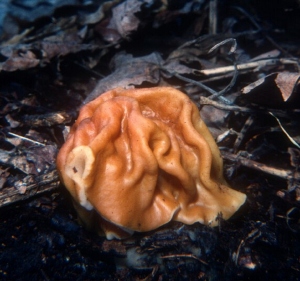Written by Walt Sturgeon
Originally Published in the January/February 2006 Mushroom Log
Springtime morel hunting results in occasional encounters with false morels in the genus Gyromitra and Verpa. None of these are considered choice edibles and at least one species is sometimes fatal. None have the honey comb like cap of a true morel. All the Gyromitra species should not be eaten.
There are 2 species of Verpa (thimble caps). The common one in Ohio is Verpa conica (smooth thimble cap). It grows under various hardwood trees in the spring. The cap may be a bit wrinkled. It is considered edible but is not popular. Rare in most of Ohio but common in parts of Michigan is the wrinkled thimble cap, Verpa bohemica. It occurs under mixed hardwoods and can be very small or as large as the common morel. It sometimes causes digestive upsets and problems with coordination. It is counted as a morel in the morel hunting contests in Michigan. It is sometimes mistaken for a half free morel which has a hollow stipe. The Verpa has a cottony pith inside the stipe.
There are four (possibly five) species of Gyromitra which can be expected in Ohio. Only two of these are somewhat common. All are usually fist sized or larger. All are wrinkled, convoluted and described as brain like. Often they have a saddle shaped fruiting surface. Rare is the autumn false morel, Gyromitra infula which usually fruits in September and October on well decayed wood. Extreme Northeastern Ohio would be the most likely place to find it. Also rare in Ohio (unknown as far as I know but reported from Pittsburgh Pa.) is the very large Gyromitra caroliniana. Sometimes called the red false morel or big red, it is a species of the south central states. One fruiting can weigh a couple pounds. Extreme southwestern Ohio might be the place to search for this.
The brown false morel. Gyromitra fastigiata (formerly Gyromitra brunnea) usually fruits in May in low hardwood areas. It has a rich medium to dark brown pileus and can be 4 inches across. The white stipe contrasts with dark cap.
The bull nose false morel, Gyromitra korfii is yellow brown to brown and in my experience is our most common species. Macroscopically it is very similar to Gyromitra gigas which is more common in the west and in the mountains. It usually begins to fruit in April, often at the same time as the black morels.
The most controversial false morel is rare in Ohio but very common in parts of Michigan. This is Gyromitra esculenta. It usually fruits near conifer trees. It is referred to as beef steak morel in some areas and is consumed after special preparation. There have also been confirmed fatalities. Some of the toxin is removed by boiling multiple times in water and discarding the water. Reportedly cooks have been poisoned simply from breathing the steam. One of its toxins is monomethylhydrazine which has been used in rocket fuel. It is available canned and dried from Finland and probably other countries as well. I will not even consider eating this species. Neither should you. I have never found it in Ohio but it does occur here.

Gyromitra brunnea by Walt Sturgeon

Gyromitra esculenta by Walt Sturgeon

Gyromitra korfii by Walt Sturgeon
All rights reserved. This article may not be reproduced or distributed without specific permission.

I’ve just today found a Gyromitra korfii and this really helped me to identify it thanks.
Awesome, good for you. Not an edible, but pretty cool looking and used in rocket fuel because of it’s high concentration of monomethylhydrazine.
An excellent article everyone should be reading for mushroom hunting around this time. Thanks Walt!
If you are going for best contents like me, simply visit this website all the
time because it provides feature contents, thanks
Great blog here! Also your website so much up fast! What host are
you the usage of? Can I am getting your associate hyperlink in
your host? I want my web site loaded up as quickly as yours
lol
I’ve always eaten the false morel, with no side effects.
I report what I’ve seen in Washtenaw County, MI, west of Ann Arbor. G. esculenta very rare, G fastigiata pretty uncommon and isolated, but I see it most years (saw one today). G. korfii rare but tons in the NW corner of Stinchfield Woods. I and others have eaten it many times, but no longer suggest eating it due to the reports from other places. It took me a decade to positively ID it, and test it using “the usual precautions”, in pre-web days. Doesn’t come every year is part of the difficulty. Comes earlier than black morel here. Often large. Was amazed to hear it is most common in Ohio. Thanks.
Pingback: #209: Gyromitra caroliniana, Big Red – Fungus Fact Friday